- close-up with an elephant
- bathing-time!
- impossible to describe in words how it feels to be so close to an elephant
- beauuutiful sunsets over the lake
- stick insect
- morning pick-up of elephants from the jungle
- foster-mom and baby on their way to a bath in the lake
- all shades of green
- panoramic view from my hut
- baby elephants gets a ‘shower’ as he is still too scared to go swimming in the lake
- bady inspection of one of the guides!;)
- baby trunk resting on my broken toe (he knew I was hurting!)
- amazingly soft foot soles of a fully grown elephant
- the funniest sensation of feeling the playful trunk!
- I like your sunglasses!
- sugarcane feeding time!
- one of the mahouts with a colorful bug on his chest
- every day a rainbow
- sunset river cruise with swimming time
- rainbow colored bug
- view of the Elephant Conservation Center from the lake
- the baby orphan gets 22 liters of milk every day!
- how many elephants do you see?
- mahouts have an amazing balance on the elephants
- a vet is always around the baby to take care of it
- nap time
- my first encounter with one of the 2 babies. yeyyy so wonderful!!
- ..a bit shy in the beginning…
- a long elephant ride through dense jungle, finishing off by the lake
- view from the top of an elephant (damn high!)
- make and female playing around
- fascinating how human the eyes of an elephant are
- this was the first impression I saw when I arrived at the Center. Elephant heaven!
- mahout with his elephant
- after my first jungle ride
- view from the restaurant
The Elephant Conservation Center is probably one of the few places you can visit where it’s not about elephants adapting to people’s schedules and needs but where people adapt to the rhythm and needs of the elephants. If you care about the well-being of the elephants and if you care about supporting people who really care about elephants then this is the place to visit.
Located in Sayaboury Province (about 3,5-4 hours by bus from Luang Prabang) the Center is the perfect hideaway from mass tourism routes and is set amidst the most beautiful scenery in the protected area of the Nam Tien lake.
 The Elephant Conservation Center hosts Laos’ first (and only) hospital dedicated to elephant victims of logging accidents and affected by diseases. Now it is possible to transport sick or injured elephants to the Center where they will receive the best medical care currently available in Laos.
The Elephant Conservation Center hosts Laos’ first (and only) hospital dedicated to elephant victims of logging accidents and affected by diseases. Now it is possible to transport sick or injured elephants to the Center where they will receive the best medical care currently available in Laos.
The Center also has an Elephant Nursery which is an innovative reproduction project led by Lao mahouts (a mahout is the person taking care of an elephant) and the Center. It relies on voluntary participation and aims to support mahouts involved in logging to bear the cost of breeding their elephant. The long pregnancy and milk-feeding would mean (5 years all together) a huge monetary loss for the mahouts as they make a couple of thousand USD with the logging every month and therefore many of the owners prevent their elephants from reproducing which leads to a drastically declining population of elephants in Laos. The objective of the nursery is to offer the best environment to the most important elements of the declining elephant population of Laos. Because they are not sufficiently rested or are returned to work too early, many mother elephants stop milking before it is safe for their offspring to feed on solid foods. This often results in the calf becoming too weak to survive. Reproductive rates are critically low in Laos and it is of the utmost importance to safeguard currently pregnant cows, young ones and encourage mahouts to breed their elephants.
I am very picky when it comes to choosing an Elephant “place” as there are far too many all over the world which treat their elephants badly and which just means moving from one horrible life (=logging) to another (= bad treatment for tourism purposes).
I have heard good things about the ECC and I am so happy I went there because out of all the elephant encounters I have had in my life this was by far the most stunning one.
Right when you arrive at the boat landing and make your way to the ECC across the Nam Tien lake you are welcomed by jaw-dropping views. The mountainous region combined with the beautiful lake and the lush jungle displaying literally all shades of green was an amazing welcome. The little basic bungalows sit up on the hill, overlooking the lake and offering sunrises and sunsets deluxe. We even had a complimentary rainbow every day!
During my 3 day stay I had so much 1:1 time with elephants that this can’t be topped. Ever. I was also lucky to go there in rainy season as this time of the year scares off most people ((which it shouldn’t really as this season is great too) so on my first day I was there alone and then we were 3 people the following 2 days.
I started the morning with a short walk into the jungle where we picked up the elephants who stay there over night. I loved that moment when you reach those majestic animals and they stick their head out of the bushes. Seeing those animals in their natural surrounding is incomparable to any zoo experience. I got on one of the elephant’s back and we rode back to the camp. From there we started our 1 hour jungle ride and there it really is a JUNGLE ride. You follow either very narrow paths or – like most of the time- have to create your path first. The mahouts cut bamboo and bushes with their machetes so that you don’t get them in your face when you ride on the elephant. Sometimes we walked along steep hills and sometimes the bushes came up all the way to your feet. Whenever the elephants (particularly the hungry ones) see sugarcane or other yummie plants they stop and munch away. Getting them to move in is one big challenge! Other activities during my stay included visiting the nursery by boat and watching an 18 months old baby elephant with its mother while they were bathing, getting a tour of the hospital and learning of the problems and injuries the elephants who come to the center have and how they are treated, getting a “mahout” lesson where you learn to give the commands to the elephant and (my favourite activity) spending time with the other 12 month old orphan baby elephant that was super-cute. It was found in the forest without its mother so the ECC adopted it. It is being fed 22 liters of soy milk every day by a bottle and it also munches on bamboo, rice and many plants. Since it was still too scared to go swimming the vets and volunteers showered the baby with a watering can. I was often just stitting next to the fence and waited until it would come over and curiously inspect me with its trunk (which is like a drunk boa constrictor). I had broken one of my toes on my second day there (a table foot ran into my toe, seriously;) and had a bandage around my toes. When I sat down next to the fence the baby elephant softly laid his trunk on my broken toe and rested it there – as if he somehow knew that I was hurting. Every time I stroked an elephant and looked them closely in their eyes I felt as if I was looking into a person’s eye. Their eyes are so human and they have so much charisma that I was enchanted every minute I spent with them.
The end of the days were celebrated with a nice sunset cruise with the boat and going for a relaxing swim in the warm lake, followed by a wonderful tasty dinner and a good night sleep with beautiful jungle noises lulling you to sleep.
I can highly recommend the Elephant Conservation Center to everyone who is looking for an authentic experience and respectful handling of those incredibly sensitive, majestic and smart creatures.
P.S.:
Here are some facts about elephants that I learned that found very interesting:
- female elephants have a gestation period of 22 months and they give milk to their babies for 3 years! (they can get pregnant every 4 years only so they can have about 4 babies in their lifetime)
- a domesticated elephants begins with its mahout training when he is 3 years old and the traning takes 2 years. In this time they learn up to 50 commands and to follow their mahout
- Asian elephants weigh about 2,5 to 3,5 tons
- they are vegetarians and eat approx 200-250 kilos and drink about 100 liters of water PER DAY!
- they can suck up about 7-8 liters of water in their trunk
- they are so sensitive that they can not only pull heavy tree trunks but also pick up a small coin with the tip of their trunk
P.P.S.:
- the baby elephant wa too big to put into by backpack:(





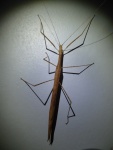



















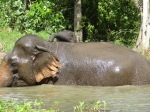
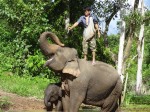












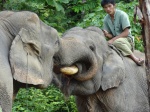
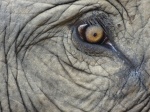
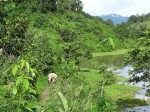

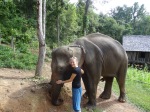
[…] visited the center and recognized its role in protecting the welfare of […]
[…] ihrem Besuch [en] des Zentrums konnte sich Brita von dem Einsatz des Zentrums für des Wohlergehens der […]
[…] Brita在拜访过保育中心后,了解到中心成立的目地是为了捍卫大象的福利: […]
[…] odwiedziła ośrodek i przyznała mu pozytywną rolę w kształtowaniu dobrego życia […]
[…] زارت بريتا المركز وتعترف بدوره الإيجابي للفيلة: […]
[…] Britaは保護センターを訪れてみて、象の幸福を守るという同センターの役割について理解した。 […]